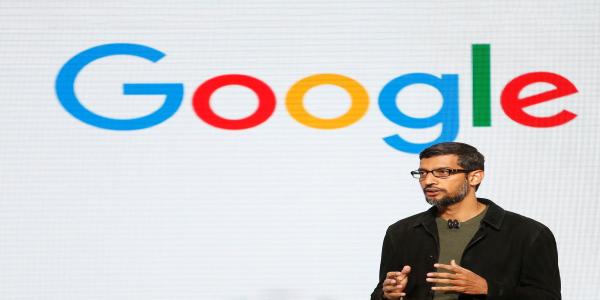Material Design launched in 2014, and it was mostly thought of as a new design language for Android — though it later came to the web and iOS. It had a bold idea: there should be a physicality to software design not unlike the physicality of paper. It should follow some rules that are almost physical, with layers of magic paper and strictures for how different software elements like buttons and drawers should behave.
“We went out with the original Material Design with what was a very fresh and very opinionated style. We wanted to get attention,” says Matias Duarte, the head of the Material Design group at Google. “And it was so strong and so opinionated and so successful, a lot of both the designer and developer community took it as a ‘gospel,’ perhaps is the right word.”
Duarte, along with seven other designers at Google, was speaking to about a dozen reporters about what’s next for Material Design, Google’s system for creating software design. Maybe it’s the (lapsed) Lutheran in me, but calling the original Material Design a “gospel” struck a chord. It was religiously adhered to by the Android faithful ever since it launched. Apps that followed Material Design were holy; apps that didn’t were anathema. I can’t count the number of times I saw an app get dismissed by the Android community because it wasn’t updated for Material Design.
And to extend the metaphor (yes, please grant me an indulgence on this), it was also a very restrictive doctrine. The tools it offered helped make many Android apps feel consistent, but it also stripped away too much differentiation between them. They all ended up feeling the same. More importantly, many app makers didn’t want to give up their brand to Material Design. It made too many apps look and feel identical.
Simply put, people were being too dogmatic about how Material Design apps should look.
/cdn_vox-cdn_com/uploads/chorus_asset/file/10814219/fab.gif)
”We spent two years telling people ‘this is how to make Material yours,’” Duarte says, “and it didn’t work.” But he doesn’t blame developers. The problem is that Google didn’t provide the right tools. Specifically, he believes Google’s guidelines didn’t separate out the styling of the button from its function. Google wants apps to work like other Material Design apps, but it never meant for all Android apps to look like each other.
That’s why, yesterday, Google unveiled the next stage for Material Design. Explicitly notcalled “Material Design 2,” it is instead a suite of tools and guidelines for designers to extend and expand the Material Design philosophy with their own brand styles. In essence, Google wants to keep the functionality of Material Design to maintain consistency across apps, but give developers tools to adapt it to their design needs.
Google is offering updated stylistic guidelines and a suite of tools for app designers to take the fundamentals of Material Design and customize it for their brand or product. There’s a new Material Theme editor that designers can use to build up their custom style on top of Material and new icon packs and palette tools for choosing colors. Google has begun using this system itself, creating its own Google-fied take on Material Design for the new Gmail and Tasks apps.
Rachel Been, the design lead for the new Material Design, says that the tools for creating design systems based on Material are just as important as the core design guidelines themselves — if not more so. “We had to create the full infrastructure,” she says. So there are palette tools and font tools to help designers create a version of Material Design that feels native to their brand but also comprehensible to users.
”We like to talk about it as infinite possibilities, with guardrails,” Been says. “We still had those inherent building blocks of usability. Where a button really still maintains the usability and understandability of a button.” But now, that button (in Android parlance, it’s often a “Floating Action Button,” or FAB) can be more than a floating circle. Lyft, for example, now uses a longer lozenge-shaped button, but it still feels like a native Android app.
/cdn_vox-cdn_com/uploads/chorus_asset/file/10814227/theme.png)
The theme editor allows designers to set up certain core design elements and then “cascade” them across their app, Been explains. So, for example, if you had a certain curved corner that was important to your design, the theme makes it easier to apply that curve everywhere in your app.
Duarte describes it as “a design system for making design systems.” So the original version of Material Design had a single theme that was getting applied to all apps with minimal customization. The new Material Theme tools are meant to help developers create their own design systems — systems that are nevertheless based on Material Design principles.
The core idea behind Material Theming is that “we’ve created a separation between the style and the function that had been missing in software development,” Duarte argues. “Now, we’ve created a model where those two things are separable. So that you can get the consistency, the usability, the discoverability, the expected components… and independently, we can iterate and express on the style.”
If you read between the lines there, you’ll find a radical rejection of skeuomorphism. In the Material Design world, the way a software element looks shouldn’t be slavishly tied to what it does.
There needs to be a system for how buttons and sliders and hamburger menus work, of course, and Material is still a strongly “opinionated” system in that regard. Been points to the fact that “elevation” is still important: there needs to be a consistency to how elements float over other elements to indicate their importance.
The idea, then, is that users will build a mental model of how software operates across different apps. That model should give developers more freedom to interpret the scripture — er, guidelines — of Material Design when they start choosing their colors and buttons and whatever else.
But don’t expect an instant rollout. Duarte believes that the first iteration of Material Design didn’t propagate quickly enough throughout Google and is eager to see it happen more quickly this time around. The tools that his team has created should help internally with that, and, theoretically, they should also help third-party developers do the same.
If it works out, Duarte is hoping that his design language will be adopted by many apps across Android, iOS, and the web — but that none of them will so strictly follow the way that Google is doing it. To beat the metaphor into the ground: as the Protestant Reformation encouraged the laity to interpret the Bible themselves, Google wants each designer to come up with their own interpretation of how Material Design should look.
When I asked if this new, more flexible system would mean that Google would be more aggressive in asking developers to adopt Material Design, Duarte simply said, “Yeah. Please use it.” It’s not as dramatic as pounding 95 theses on a church door, but it’ll do.
Source by:- theverge





